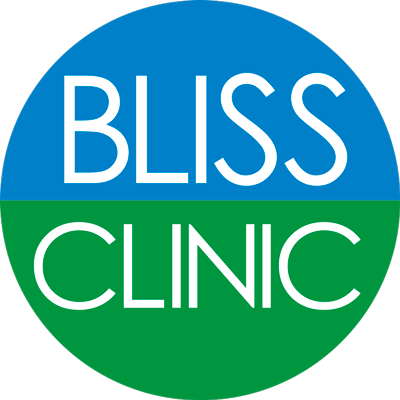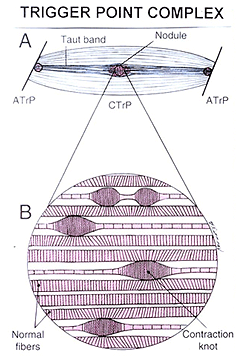
Myofascial Trigger Points
Trigger points are exquisitely tender points or knots in muscles and other soft tisssues which cause pain and tenderness to be referred to distant sites in the body.
Trigger Points causing chest, arm pain and numbness
For example, a trigger point in the pectoral (chest) muscle can cause not only local chest pain but also pain and numbness radiating to the arm and hand. It can mimic the symptoms of angina or heart attack, but it is not a
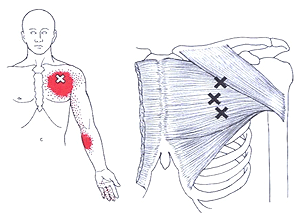
heart problem; it is a muscle problem. It often produces distressing numbness in the hands and, not infrequently, cardiac arrythmia. Sometimes pain and/or swelling of the breast. These various symptoms go away when the trigger point is inactivated with proper treatment. Proper treatment includes not only eliminating the offending trigger points in the in the chest muscle but also identifying and correcting its causes which can be manifold – poor posture, poor ergonomics, overuse of the muscle, certain metabolic imbalances such as low blood sugar or thyroid hormone levels and certain vitamin insufficiencies etc. All of these can perpetuate or aggravate the activity of trigger points.
Trigger Points causing low back and leg pain – “sciatica”
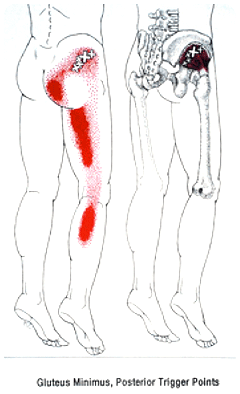 Similarly, a trigger points in the Gluteus Minimus , a hip muscle, can produce a severe type of low back and leg pain, much like that of a ‘pinched nerve’ caused by sciatica or a disc herniation. It is an often overlooked cause of back pain radiating to the leg. It is not picked up on routine medical testing such as X-ray or MRI, because it is a muscle problem. It is detected by palpation and manual examination alone. A whole-body examination is also needed to sort out the causes of this painful trigger point condition. Common causes stem from mechanical problems in the low back, a short leg or fallen arch, in addition to poor ergonomics. Failure to correct these underlying causes is often the main reason why the pain comes back time and time again regardless of temporary success with treatment. Just treating the trigger point alone is not enough; eliminating its perpetuating factors and causes is the decisive factor in giving long-term success.
Similarly, a trigger points in the Gluteus Minimus , a hip muscle, can produce a severe type of low back and leg pain, much like that of a ‘pinched nerve’ caused by sciatica or a disc herniation. It is an often overlooked cause of back pain radiating to the leg. It is not picked up on routine medical testing such as X-ray or MRI, because it is a muscle problem. It is detected by palpation and manual examination alone. A whole-body examination is also needed to sort out the causes of this painful trigger point condition. Common causes stem from mechanical problems in the low back, a short leg or fallen arch, in addition to poor ergonomics. Failure to correct these underlying causes is often the main reason why the pain comes back time and time again regardless of temporary success with treatment. Just treating the trigger point alone is not enough; eliminating its perpetuating factors and causes is the decisive factor in giving long-term success.
Trigger Points causing ‘arthritic’ joint pain and headaches
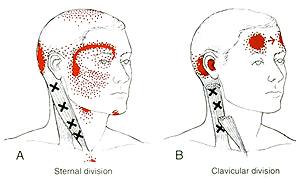 Like tooth cavities, trigger points are ubiquitous. Active trigger points produce acute and chronic pain, often very severe. Latent (subclinical, silent) trigger points become symptomatic when they are irritated by various physical, environmental and even emotional stresses. They occur at any age in any muscle and can remain as active or latent pain-producers in the body for many years or even a whole lifetime, if not corrected. World expert in trigger points, Dr. Janet Travell MD, states that trigger points are the most overlooked and neglected source of pain in the human body. It has been established that most conditions of chronic, relapsing pain anywhere in the body have some degree of significant trigger point involvement which causes or adds to the pain picture. This includes arthritic joints, headaches, back pain, overuse injuries, sprains and pinched nerves. Full relief from these common pains often comes about only after the offending trigger points have been thoroughly identified and eliminated. This, of course, requires thorough and specialized knowledge and treatment techniques. This is what we do at Bliss Clinic. We are a leader in this field of pain management in Finland.
Like tooth cavities, trigger points are ubiquitous. Active trigger points produce acute and chronic pain, often very severe. Latent (subclinical, silent) trigger points become symptomatic when they are irritated by various physical, environmental and even emotional stresses. They occur at any age in any muscle and can remain as active or latent pain-producers in the body for many years or even a whole lifetime, if not corrected. World expert in trigger points, Dr. Janet Travell MD, states that trigger points are the most overlooked and neglected source of pain in the human body. It has been established that most conditions of chronic, relapsing pain anywhere in the body have some degree of significant trigger point involvement which causes or adds to the pain picture. This includes arthritic joints, headaches, back pain, overuse injuries, sprains and pinched nerves. Full relief from these common pains often comes about only after the offending trigger points have been thoroughly identified and eliminated. This, of course, requires thorough and specialized knowledge and treatment techniques. This is what we do at Bliss Clinic. We are a leader in this field of pain management in Finland.
Specialized Trigger Point treatment methods at Bliss Clinic
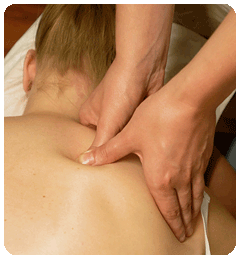 Dr. Bliss Sr. has studied and lectured about triggers points and pain for over 20 years. He has lectured internationally to medical, dental, chiropractic, podiatric and massage professionals. Through his years of experience he has developed a range of specialized treatment methods for treating pain, including pain from the omnipresent trigger point. The staff at Bliss Clinic has been trained with this specialized knowledge. We are unique in this area of therapeutics in Finland.
Dr. Bliss Sr. has studied and lectured about triggers points and pain for over 20 years. He has lectured internationally to medical, dental, chiropractic, podiatric and massage professionals. Through his years of experience he has developed a range of specialized treatment methods for treating pain, including pain from the omnipresent trigger point. The staff at Bliss Clinic has been trained with this specialized knowledge. We are unique in this area of therapeutics in Finland.
A full range of treatment techniques is used depending on the case: various trigger point massage techniques, specialized ultrasound, laser, magnetic therapy and needling techniques, heat treatments, correction of vitamin/mineral and other metabolic imbalances and specialized stretching techniques. Advice on “do’s and dont’s” is always an important part of successful trigger point management. We take the time to educate the patient at the same time as fixing the problem.
